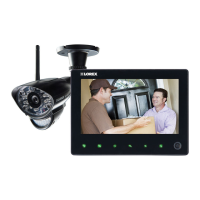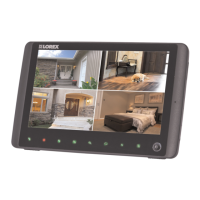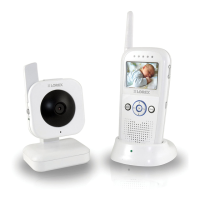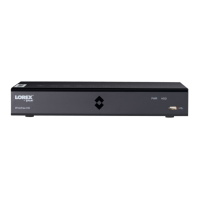Do you have a question about the Lorex LW2700 SERIES and is the answer not in the manual?
Safety precautions and warnings related to product installation and operation.
Warnings and guidelines for safe installation and electrical handling.
Provides multiple channels for customer support, including online, email, and phone.
Essential steps before installation, including reading guides and seeking assistance.
Critical safety measures for installation, power, ventilation, and electrical connections.
Guidelines for safe servicing, cleaning, and avoiding hazards like water or overloading.
Important warnings for general use, including cleaning and ventilation.
Regulatory information regarding FCC compliance for the device.
Details on the advanced digital wireless technology used in the surveillance system.
Features of the LCD monitor, including recording, viewing options, and intercom.
Key features of the wireless cameras, including resolution, night vision, and weather resistance.
Appendices covering system specs, technology, setup, range, files, times, power, and troubleshooting FAQs.
List and visual identification of all components included in the surveillance system package.
Identification and description of the rear panel ports, buttons, and indicators on the LCD receiver.
Detailed explanation of each component of the camera, including sensor, lens, and speaker.
Explanation of the remote control buttons and their corresponding functions for system operation.
Crucial warnings and step-by-step instructions for securely mounting and connecting the camera.
Instructions for attaching the tabletop stand and positioning the LCD receiver for optimal viewing.
Steps for connecting the power adapter and adjusting the antenna for best reception.
Guide for mounting the LCD receiver under counters, on walls, or ceilings using provided brackets.
Completing the receiver setup by connecting power and finalizing its placement.
Explanation of the blue LED indicators on the LCD receiver and their meanings.
Overview of the on-screen display elements and indicators during live viewing.
Further details on on-screen display elements like signal, recording, and file status.
Instructions on how to navigate and select different display modes like Auto Sequence, Quad, and Screen Saver.
Detailed explanation of the Quad mode for viewing up to four cameras simultaneously.
Steps to enable and customize the screen saver feature, including selecting display images.
How to use motion detection in conjunction with the screen saver for event notification.
Procedure for setting the system's date and time, crucial for accurate recording and scheduling.
Summary of available recording modes: Manual, Schedule, and Motion.
Instructions for manually starting and stopping video recording from a single camera.
Guide to setting start and stop times for automatic continuous recording based on a schedule.
Steps to enable schedule recording and how to manually stop an ongoing scheduled recording.
Instructions for setting up the system to record only when motion is detected by a camera.
Tips and best practices for using motion recording, especially with multiple cameras.
Steps to access and play back recorded video files directly on the LCD receiver.
How to navigate through recorded video files and folders for playback.
Using remote control buttons to play, pause, fast-forward, rewind, and adjust volume during playback.
Instructions for viewing recorded video files on a computer using an SD card reader.
Guide on using the intercom feature for two-way audio communication between receiver and camera.
Description of the main menu structure and its primary function categories.
Procedure for enabling or disabling individual cameras from the system display.
Overview of the sub-menus available in the Record menu: Quality, Trigger Record, Schedule, and Overwrite.
How to select the image resolution (QVGA or VGA) for recording to optimize quality or recording time.
Configuring the recording duration after a motion detection event occurs.
Detailed steps for setting specific start and stop times for scheduled continuous recording.
Instructions for enabling or disabling the automatic overwrite of old data when the SD card is full.
Explanation of the pairing process for wireless devices and its importance for communication.
Step-by-step guide for pairing additional cameras to the wireless receiver, expanding system capacity.
Introduction to the settings menu and its various sub-options for system customization.
Procedure for setting the system's date and time, crucial for accurate recording and scheduling.
How to adjust the brightness level of the LCD screen for optimal viewing.
Guide for selecting the appropriate TV system output (NTSC or PAL) for external display.
Steps to enable the screen saver and choose from pre-loaded scenic images or a blank screen.
How to increase or decrease the alarm buzzer volume and the volume for button presses.
Instructions for enabling 1X or 2X digital zoom and how to scan images while zoomed.
Procedure for formatting the SD card, a recommended step before initial recording.
Steps to restore the system to its original factory settings, excluding date/time and video files.
Technical specifications for the general operation of the surveillance system.
Detailed technical specifications for the camera and the LCD receiver unit.
Technical explanation of the Frequency Hopping Spread Spectrum (FHSS) transmission method.
Step-by-step guide for pairing additional cameras to the wireless receiver, expanding system capacity.
Methods to improve wireless signal strength, including clear line-of-sight and obstacle avoidance.
Information on using directional and omni-directional antennas to extend wireless range.
Procedure for deleting video files directly from the SD card using the system interface.
Table estimating recording times based on SD card capacity and video resolution.
Explanation of how the system behaves during and after a power failure, including restart modes.
A guide to diagnosing and resolving common problems encountered with the system's cameras and receiver.
Answers to common questions regarding system operation, recording, and basic functions.
Answers related to wireless range, device pairing, and available system accessories.
Answers specific to screen saver functionality, signal privacy, and recording capabilities.
Answers regarding the A/V output feature, including image display on TV/monitors.
Answers concerning system settings like clock format and video playback on computers.
Details of the limited warranty, including coverage periods and specific exclusions.
Instructions on how to register the product and obtain warranty service or repairs.
Safety precautions and warnings related to product installation and operation.
Warnings and guidelines for safe installation and electrical handling.
Provides multiple channels for customer support, including online, email, and phone.
Essential steps before installation, including reading guides and seeking assistance.
Critical safety measures for installation, power, ventilation, and electrical connections.
Guidelines for safe servicing, cleaning, and avoiding hazards like water or overloading.
Important warnings for general use, including cleaning and ventilation.
Regulatory information regarding FCC compliance for the device.
Details on the advanced digital wireless technology used in the surveillance system.
Features of the LCD monitor, including recording, viewing options, and intercom.
Key features of the wireless cameras, including resolution, night vision, and weather resistance.
Appendices covering system specs, technology, setup, range, files, times, power, and troubleshooting FAQs.
List and visual identification of all components included in the surveillance system package.
Identification and description of the rear panel ports, buttons, and indicators on the LCD receiver.
Detailed explanation of each component of the camera, including sensor, lens, and speaker.
Explanation of the remote control buttons and their corresponding functions for system operation.
Crucial warnings and step-by-step instructions for securely mounting and connecting the camera.
Instructions for attaching the tabletop stand and positioning the LCD receiver for optimal viewing.
Steps for connecting the power adapter and adjusting the antenna for best reception.
Guide for mounting the LCD receiver under counters, on walls, or ceilings using provided brackets.
Completing the receiver setup by connecting power and finalizing its placement.
Explanation of the blue LED indicators on the LCD receiver and their meanings.
Overview of the on-screen display elements and indicators during live viewing.
Further details on on-screen display elements like signal, recording, and file status.
Instructions on how to navigate and select different display modes like Auto Sequence, Quad, and Screen Saver.
Detailed explanation of the Quad mode for viewing up to four cameras simultaneously.
Steps to enable and customize the screen saver feature, including selecting display images.
How to use motion detection in conjunction with the screen saver for event notification.
Procedure for setting the system's date and time, crucial for accurate recording and scheduling.
Summary of available recording modes: Manual, Schedule, and Motion.
Instructions for manually starting and stopping video recording from a single camera.
Guide to setting start and stop times for automatic continuous recording based on a schedule.
Steps to enable schedule recording and how to manually stop an ongoing scheduled recording.
Instructions for setting up the system to record only when motion is detected by a camera.
Tips and best practices for using motion recording, especially with multiple cameras.
Steps to access and play back recorded video files directly on the LCD receiver.
How to navigate through recorded video files and folders for playback.
Using remote control buttons to play, pause, fast-forward, rewind, and adjust volume during playback.
Instructions for viewing recorded video files on a computer using an SD card reader.
Guide on using the intercom feature for two-way audio communication between receiver and camera.
Description of the main menu structure and its primary function categories.
Procedure for enabling or disabling individual cameras from the system display.
Overview of the sub-menus available in the Record menu: Quality, Trigger Record, Schedule, and Overwrite.
How to select the image resolution (QVGA or VGA) for recording to optimize quality or recording time.
Configuring the recording duration after a motion detection event occurs.
Detailed steps for setting specific start and stop times for scheduled continuous recording.
Instructions for enabling or disabling the automatic overwrite of old data when the SD card is full.
Explanation of the pairing process for wireless devices and its importance for communication.
Step-by-step guide for pairing additional cameras to the wireless receiver, expanding system capacity.
Introduction to the settings menu and its various sub-options for system customization.
Procedure for setting the system's date and time, crucial for accurate recording and scheduling.
How to adjust the brightness level of the LCD screen for optimal viewing.
Guide for selecting the appropriate TV system output (NTSC or PAL) for external display.
Steps to enable the screen saver and choose from pre-loaded scenic images or a blank screen.
How to increase or decrease the alarm buzzer volume and the volume for button presses.
Instructions for enabling 1X or 2X digital zoom and how to scan images while zoomed.
Procedure for formatting the SD card, a recommended step before initial recording.
Steps to restore the system to its original factory settings, excluding date/time and video files.
Technical specifications for the general operation of the surveillance system.
Detailed technical specifications for the camera and the LCD receiver unit.
Technical explanation of the Frequency Hopping Spread Spectrum (FHSS) transmission method.
Step-by-step guide for pairing additional cameras to the wireless receiver, expanding system capacity.
Methods to improve wireless signal strength, including clear line-of-sight and obstacle avoidance.
Information on using directional and omni-directional antennas to extend wireless range.
Procedure for deleting video files directly from the SD card using the system interface.
Table estimating recording times based on SD card capacity and video resolution.
Explanation of how the system behaves during and after a power failure, including restart modes.
A guide to diagnosing and resolving common problems encountered with the system's cameras and receiver.
Answers to common questions regarding system operation, recording, and basic functions.
Answers related to wireless range, device pairing, and available system accessories.
Answers specific to screen saver functionality, signal privacy, and recording capabilities.
Answers regarding the A/V output feature, including image display on TV/monitors.
Answers concerning system settings like clock format and video playback on computers.
Details of the limited warranty, including coverage periods and specific exclusions.
Instructions on how to register the product and obtain warranty service or repairs.
| Number of Cameras | 2 |
|---|---|
| Number of Channels | 4 |
| Weatherproof Rating | IP65 |
| Compatible App | Lorex Home |
| Camera Resolution | 1080p |
| Mobile Access | Yes |
| Type | Wireless Security System |
| Wireless Camera Connectivity | Yes |
| Indoor/Outdoor Use | Outdoor |
| Camera Type | Bullet |
| Connectivity | Wi-Fi |
| Power Source | AC power adapter |
| Motion Detection | Yes |












